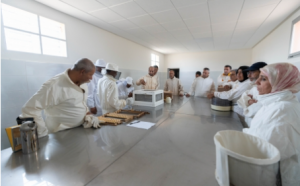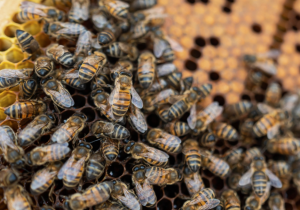The Moroccan beekeepers’ mission to preserve the Saharan Yellow Bee
Changing the fate of an extraordinary bee species for the benefit of all.
Here, in Er-rich, nestled on a plain amid Morocco’s awe-inspiring Atlas Mountains, women and men settle into a packed room as an FAO beekeeping training gets underway one March afternoon. Their whispers and laughter blend together in an undercurrent of anticipation. But their purpose is serious: to do whatever they can to ensure the very survival of a species. Throughout the day, the beekeepers of all ages will learn about the Saharan yellow bee, a species that is hardy, non-aggressive and well-adapted to local climatic and breeding conditions.
“Don’t be afraid,” the instructor, M’hamed Aboulal, reassures them. “This is the gentlest breed. That’s what makes its neighbour to the north, the black bee, ‘yellow’ with jealousy,” he says with a smile. “It’s not only beautiful in its long yellow dress, it’s also docile, produces great honey and is a better forager, since it can travel up to 8 kilometres compared to only 3 kilometres for the ordinary bee.”
Despite all these qualities, beekeepers know that the Saharan yellow bee is threatened with extinction due to successive droughts, the negative side effects of necessary pest control and the impact of other breeds of bee being introduced to the area.
The participants are impatient to ask him their questions: “How do you produce more queens?”, “What are the techniques for artificial insemination?”, “How can you help the queens to multiply?” Above all, the trainees want to know how to save the lives of the bees, which for some of them represent their very livelihoods.
Beekeeping: a passion from childhood
M’hamed dates his passion for bees back to the time when his beekeeper father let him and his siblings taste the honey barely out of the wooden hives on which they sat. Today, M’hamed is the president of both a regional beekeeping cooperative and a national association and spends his time giving theoretical and practical training to beekeepers, also increasing the appreciation of the Saharan yellow bee.
Every morning, M’hamed starts his day by going to the heights of Er-rich to inspect the apiary and its bee colonies and assess their state of health. As you approach the dozen hives there, the buzz of the bees announces their presence. For M’hamed, the experience conjures up humbling feelings.
“For them and thanks to them, I have the chance to highlight and perpetuate the know-how of my ancestors and do a job that I love and that makes me want to get up at dawn every morning to get things done.”

FAO, the government of Morocco and other partners have created a beekeeping technical center, whose mission is to improve beekeeping skills and to select, multiply and disseminate queen bees to safeguard the future of the Saharan yellow bee breed. ©FAO/Hassan Chabbi
A nationally renowned Centre
M’hamed is a regular visitor to the Centre where theoretical and practical trainings are held and which is the result of a fruitful multi-stakeholder collaboration. This is where FAO works hand in hand with the government of Morocco and other partners to safeguard this particularly interesting breed adapted to oasis areas. The combined efforts have led to the creation of this beekeeping technical Centre for Developing and Safeguarding the Saharan Yellow Bee and Biodiversity, whose mission is to improve beekeeping skills and to select, multiply and disseminate queen bees.
The Regional Office for Agricultural Development of Tafilalet hosts this Centre and makes it available to the Chifae Beekeeping Cooperative in Errachidia of which M’hamed is the founder. The Centre hosted there is part of FAO’s project, “Revitalizing oasis agroecosystems through a sustainable integrated and landscape approach in the Draâ-Tafilalet region.”
Safeguarding, preserving and developing the Saharan yellow bee is key to these objectives. They are crucial for enhancing and protecting local agro-biodiversity, improving the incomes of smallholders and providing employment for women and youth.
Among the functions of the Centre are selecting the bees, producing queens through artificial insemination, promoting and distributing them to help reconstitute Saharan yellow bee populations and training beekeepers in setting up and managing cooperatives.

©FAO/Hassan Chabbi
The risk of collapse
Recently, bee populations have suffered spectacular losses, never seen before. A phenomenon known as “Bee Colony Collapse Disorder” has been observed in countries in Europe, the Americas and Africa. Beekeepers have reported the sudden and unexplained disappearance of bee colonies, followed by the death of the workers, the survival of the queen alone and consequently the loss of the hives.
The phenomenon is causing growing concern among both breeders and specialists such as M’hamed who says, “If this continues, the consequences of this unexpected disappearance would be heavy given the importance of apiaries and bees in the ecological and agricultural balance and economic development, as well as the importance of the sector in terms of jobs.”
Several factors are being blamed, such as insufficient rainfall, poor bee nutrition resulting from lack of pasture, the health of hives and bee husbandry practices, with governments redoubling their efforts at research to pinpoint the causes. According to M’Hamed, the Saharan yellow bee seems relatively less impacted by this phenomenon of colony collapse. But given the many other threats it faces, FAO and its partners are clear that there must be no let-up in their efforts to preserve and revitalise the species.
Through the efforts at the Centre, FAO and its partners continue to fight for the Saharan yellow bee. By establishing a network of professional beekeepers and setting up a number of nursery units for the multiplication and distribution of the Saharan yellow bee, the programme is working to preserve this species and encouraging other cooperatives and micro-enterprises to do the same, sharing this mission with the community and beyond.